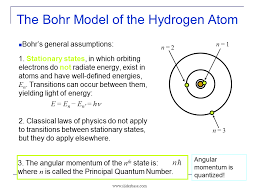Chemistry Notes On – Bohr Theory Of Hydrogen Atom – For W.B.C.S. Examination.
Bohr model of the hydrogen atom was the first atomic model to successfully explain the radiation spectra of atomic hydrogen. Niels Bohr introduced the atomic Hydrogen model in the year 1913.Continue Reading Chemistry Notes On – Bohr Theory Of Hydrogen Atom – For W.B.C.S. Examination.
Bohr Model of the hydrogen atom attempts to plug in certain gaps as suggested by Rutherford’s model. It holds a special place in history as it gave rise to quantum mechanics by introducing the quantum theory.
Planetary Model of the Atom
Quantum mechanics emerged in the mid-1920s. Neil Bohr, one of the founders of quantum mechanics, was interested in the much-debated topic of the time – the structure of the atom. Numerous atomic models including the theory postulated by J.J Thompson and the discovery of nucleus by Ernest Rutherford had emerged. But Bohr supported the planetary model, which asserted that electrons revolved around a positively charged nucleus just like the planets around the sun.
The hydrogen atom played a special role in the history of physics by providing the key that unlocked the new mechanics that replaced Newtonian mechanics. It started with Johann Balmer’s discovery in 1884 of a mathematical formula for the wavelengths of some of the spectral lines emitted by hydrogen.
The next step was Rutherford’s discovery of the atomic nucleus in 1912. After that, one knew the basic structure of atoms—a positive nucleus surrounded by negative electrons. Within a year Niels Bohr had a model of the hydrogen atom that “explained” the spectral lines. Bohr introduced a new concept, the energy level. The electron in hydrogen had certain allowed energy levels, and the sharp spectral lines were emitted when the electron jumped from one energy level to another. To explain the energy levels, Bohr developed a model in which the electron had certain allowed orbits and the jump between energy levels corresponded to the electron moving from one allowed orbit to another.
The Classical Hydrogen Atom
With Rutherford’s discovery of the atomic nucleus, it became clear that atoms consisted of a positively charged nucleus surrounded by negatively charged electrons that were held to the nucleus by an electric force. The simplest atom would be hydrogen consisting of one proton and one electron held together by a Coulomb force of magnitude.
the hydrogen atom is such a simple system, with known masses and known forces, that it should be a straightforward matter to make detailed predictions about the nature of the atom. We could use the orbit program, replacing the gravitational force GMm/r2 by e2/r2 . We would predict that the electron moved in an elliptical orbit about the proton, obeying all of Kepler’s laws for orbital motion.
There is one important point we would have to take into account in our analysis of the hydrogen atom that we did not have to worry about in our study of satellite motion. The electron is a charged particle and accelerated charged particles radiate electromagnetic waves. Suppose, for example, that the electron was in a circular orbit moving at an angular velocity ? as shown in Figure (1a). If we were looking at the orbit from the side, as shown in Figure (1b), we would see an electron oscillating up and down with a velocity given by v=v0sin ?t .
If electrons oscillated up and down at a frequency ? , they produced radio waves of the same frequency. Thus it is a prediction of Maxwell’s equations that the electron in the hydrogen atom should emit electromagnetic radiation, and the frequency of the radiation should be the frequency at which the electron orbits the proton.
For an electron in a circular orbit, predicting the motion is quite easy. If an electron is in an orbit of radius r, moving at a speed v, then its acceleration a is directed toward the centre of the circle and has a magnitude
\vec{a} = \frac{v^2}{r}
Using Equation 1 for the electric force and Equation 2 for the acceleration, and noting that the force is in the same direction as the acceleration, as indicated in Figure (2), Newton’s second law gives,
\frac{e^2}{r^2}=\frac{mv^2}{r}
One factor of r cancels and we can immediately solve for the electron’s speed v to get v2 = e2/mr, or![]()
The period of the electron’s orbit should be the distance 2?r travelled, divided by the speed v, or 2?r/v seconds per cycle, and the frequency should be the inverse of that, or v/2?r cycles per second. Using Equation 4 for v, we get

According to Maxwell’s theory, this should also be the frequency of the radiation emitted by the electron.
Please subscribe here to get all future updates on this post/page/category/website


 Toll Free 1800 572 9282
Toll Free 1800 572 9282  mailus@wbcsmadeeasy.in
mailus@wbcsmadeeasy.in



















































































































